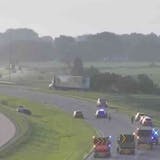Opinion editor's note: Star Tribune Opinion publishes a mix of national and local commentaries online and in print each day. To contribute, click here.
•••
For a lifetime I'd wanted to experience the home of mankind's first atomic blast. Trinity Site opens just two days a year, but I was lost in the remote New Mexico desert. Finally, a distant caravan led to the gates. That only a few dozen of us shuffled inside the barbed wire surprised me. I expected a crowd.
Now, with the film "Oppenheimer," moviegoers are experiencing Trinity Site, huddled together in the dark around a bright screen. Just as the real J. Robert Oppenheimer huddled with his team of scientists, waiting for humanity's brightest flash to bleach the night sky.
What compels millions to witness this onscreen re-creation? Historical curiosity? Sure, we're interested in the enigmatic physicist.
But could it be there's a part of the atomic bomb's father in all of us?
Back inside Trinity's gate, I make my way to the stone obelisk marking Ground Zero. A humbling privilege akin to walking a neighborhood walloped by an F5 tornado. Except instead of obliterated houses across the ground, a secret haunts the desert sand.
That on July 16, 1945, at 5:29 a.m., hell on earth unleashed where I stood. And for an instant, the blast was hotter than our sun. Sand swirled up inside the fireball and rained down as molten radioactive liquid, a new form of glassy green rock dubbed Trinitite.



